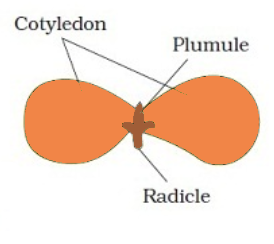
Answer
447.3k+ views
Hint: Plants undergo sexual reproduction to form a zygote that develops into an embryo. The process of fertilization to form a zygote occurs in the ovule. The ovule, after fertilization, develops into a seed. The components of a seed are seed coat, endosperm and embryo. The seed coat protects the growing embryo. The endosperm provides nutrients to the growing embryo. The embryo, after the process of germination, develops into a seedling and then into a plant.
Complete answer:
The cotyledons or seed, leaves or embryonic leaves are all part of the embryo. They are functionally similar to a leaf. However, leaves develop from the shoot only after germination whereas cotyledons are formed once the embryo begins developing.
Seeds that only have one large cotyledon are known as monocot seeds. Species that belong to the grass family have monocot seeds. The shoot tip is called the plumule and the root tip is called the radicle. The plumule, in the case of monocots, is surrounded by coleoptile and the radicle is surrounded by a coleorhiza. Their function is to protect the shoot and root tip respectively.
Seeds with two cotyledons are known as dicot seeds. Flowering plants such as rose and magnolias, fall under this category. The cotyledons are quite large. Dicot seeds lack endosperm and the cotyledons are the source of nutrients. The shoot tip is called the plumule and the root tip is called the radicle. They lack coleoptile and coleorhiza.
Winged seeds are seeds that have a wing-like feature that helps in seed dispersal by the wind. For example, maple seeds.
The diagram shows two cotyledons therefore, the seed is a dicot seed.
Hence, the correct answer is option (A).
Note: Certain seeds such as legumes can be consumed directly. Seeds such as that of castor can be used to extract oil. Ferns and liverworts do not produce seeds. They produce haploid spores that can be easily dispersed by wind or water to various places. Seeds can be stored in seed banks at dry conditions and low temperatures. The germplasm is preserved and can also be used for genetic modification.
Complete answer:
The cotyledons or seed, leaves or embryonic leaves are all part of the embryo. They are functionally similar to a leaf. However, leaves develop from the shoot only after germination whereas cotyledons are formed once the embryo begins developing.
Seeds that only have one large cotyledon are known as monocot seeds. Species that belong to the grass family have monocot seeds. The shoot tip is called the plumule and the root tip is called the radicle. The plumule, in the case of monocots, is surrounded by coleoptile and the radicle is surrounded by a coleorhiza. Their function is to protect the shoot and root tip respectively.
Seeds with two cotyledons are known as dicot seeds. Flowering plants such as rose and magnolias, fall under this category. The cotyledons are quite large. Dicot seeds lack endosperm and the cotyledons are the source of nutrients. The shoot tip is called the plumule and the root tip is called the radicle. They lack coleoptile and coleorhiza.
Winged seeds are seeds that have a wing-like feature that helps in seed dispersal by the wind. For example, maple seeds.
The diagram shows two cotyledons therefore, the seed is a dicot seed.
Hence, the correct answer is option (A).
Note: Certain seeds such as legumes can be consumed directly. Seeds such as that of castor can be used to extract oil. Ferns and liverworts do not produce seeds. They produce haploid spores that can be easily dispersed by wind or water to various places. Seeds can be stored in seed banks at dry conditions and low temperatures. The germplasm is preserved and can also be used for genetic modification.
Recently Updated Pages
Who among the following was the religious guru of class 7 social science CBSE

what is the correct chronological order of the following class 10 social science CBSE

Which of the following was not the actual cause for class 10 social science CBSE

Which of the following statements is not correct A class 10 social science CBSE

Which of the following leaders was not present in the class 10 social science CBSE

Garampani Sanctuary is located at A Diphu Assam B Gangtok class 10 social science CBSE

Trending doubts
A rainbow has circular shape because A The earth is class 11 physics CBSE

Fill the blanks with the suitable prepositions 1 The class 9 english CBSE

Which are the Top 10 Largest Countries of the World?

How do you graph the function fx 4x class 9 maths CBSE

The Equation xxx + 2 is Satisfied when x is Equal to Class 10 Maths

Give 10 examples for herbs , shrubs , climbers , creepers

Change the following sentences into negative and interrogative class 10 english CBSE

Difference between Prokaryotic cell and Eukaryotic class 11 biology CBSE

Why is there a time difference of about 5 hours between class 10 social science CBSE





